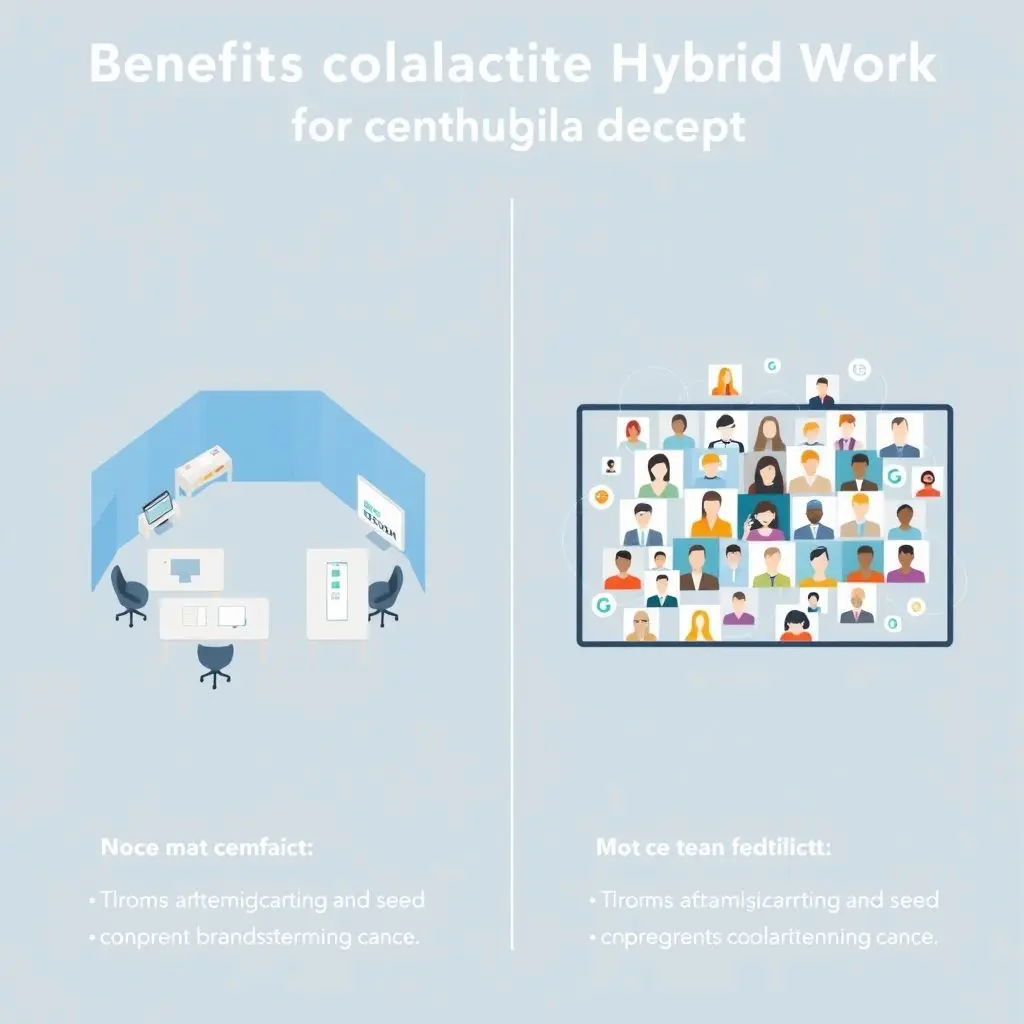Are you finding the thought of the traditional 9-to-5 office routine a little… dated? Or perhaps you’re genuinely missing those spontaneous hallway chats and coffee break catch-ups? The truth is, the world of work is undeniably shifting, and it’s settling into a model that’s neither fully remote nor fully tethered to a desk in a bustling office. The future, it seems, is decidedly… hybrid.
This isn’t about picking one extreme over the other. The hybrid model represents a smart fusion of remote days and essential in-office presence. It’s a dynamic approach designed to offer individuals greater control and flexibility over their work lives, while still acknowledging the inherent value of face-to-face interaction and collective presence.
Powering this evolution is a breathtaking array of technological advancements. We’re talking about tools that obliterate geographical barriers, keeping teams connected, collaborative, and productive, whether they’re across the street or across the continent. This fosters entirely new avenues for teamwork and innovation.
What does this seismic shift mean for you? Imagine fewer soul-crushing commutes, more time reclaimed for life outside of work, and a better equilibrium between your professional responsibilities and personal well-being. Yet, it also preserves those crucial moments of in-person connection – the quick brainstorming sessions, the team lunches, the informal knowledge sharing that builds culture and camaraderie.
Embracing hybrid work requires a fundamental rethink of deeply ingrained concepts like ‘productivity’ and ‘presence’. It pushes us to measure output and value differently, moving away from simply being ‘seen’ at a desk. As the modern mantra goes, and it bears repeating: “Work is no longer a place you go, but a thing you do.”
Curious to see a quick visual take on this? Check out this short explainer:
If the idea of ditching the perpetual cubicle view and embracing a more flexible future resonates with you, keep reading! Let’s dive deeper into what the hybrid work model truly entails.
Table of Contents
What Exactly is a Hybrid Work Model?
At its core, a hybrid work model is a flexible arrangement where employees split their time between working from a dedicated office location and working remotely (often from home). It’s not a one-size-fits-all solution and can manifest in several variations:
- Fixed Hybrid: Employees are assigned specific days to be in the office and specific days to work remotely.
- Flexible Hybrid: Employees have more autonomy to choose which days they come into the office, perhaps within certain guidelines set by the team or company.
- Remote-First with Office Access: The company primarily operates remotely, but maintains a physical office space available for employees who wish or need to use it occasionally for meetings, collaboration, or focused work away from home distractions.
- Office-First with Remote Options: The default is working from the office, but employees have the option to work remotely on certain days or for specific reasons.
Unlike purely remote work or traditional in-office setups, the hybrid model attempts to capture the benefits of both worlds while mitigating some of their drawbacks. It acknowledges that different tasks, teams, and individuals may thrive in different environments at different times.

The Driving Forces Behind the Hybrid Evolution
Why are so many organizations, from startups to established giants, leaning into hybrid arrangements? Several factors have converged to make this model not just viable, but increasingly preferable:
1. The Pandemic Paradigm Shift
The most obvious catalyst was the global pandemic. It forced a massive, unplanned experiment in remote work. While challenging initially, many companies discovered that employees could maintain or even increase productivity outside the traditional office. This experience shattered long-held beliefs that work *must* happen in a specific physical location to be effective.
2. Technological Advancements
Frankly, none of this would be truly feasible without the incredible progress in technology. Cloud computing, high-speed internet, sophisticated video conferencing platforms (like Zoom, Microsoft Teams, Google Meet), project management software (like Asana, Trello, Monday.com), and real-time communication tools (like Slack) have made seamless collaboration across distances a reality. Secure access to company resources from anywhere is now standard.

3. Employee Preferences
After experiencing the benefits of remote flexibility – be it better work-life balance, saving time and money on commutes, or the ability to customize their workspace – a significant portion of the workforce expressed a strong desire for continued flexibility. Companies recognizing this shift understand that offering hybrid options is crucial for attracting and retaining top talent.
4. Potential Cost Savings for Companies
While not the primary driver for all, adopting a hybrid model can lead to reduced real estate costs. Companies may opt for smaller office footprints, transition to shared desk spaces (hot-desking or hotelling), or repurpose office space for collaborative zones rather than individual cubicles.
5. Access to a Wider Talent Pool
Hybrid work removes geographical constraints, allowing companies to hire the best person for the job regardless of where they live. This diversifies teams and brings in new perspectives that might not be available locally.
The Technology Backbone of Successful Hybrid Work
Let’s get specific about the tech that underpins this model. It’s more than just video calls; it’s about creating a cohesive digital workspace:
- Communication Hubs: Platforms like Slack or Teams integrate chat, file sharing, and voice/video calls, serving as the central nervous system for distributed teams.
- Video Conferencing: High-quality, reliable video tools are non-negotiable for meetings, presentations, and informal check-ins, bridging the physical gap.
- Cloud Computing & Secure Access: Employees need secure, on-demand access to files, applications, and data from any approved device, anywhere. This relies heavily on robust cloud infrastructure and strong VPNs or Zero Trust Network Access (ZTNA) solutions.
- Project & Task Management: Tools that provide visibility into project progress, task assignments, and deadlines (like Asana, Jira, Trello) are essential for keeping work flowing and transparent, regardless of location.
- Digital Whiteboards & Collaboration Tools: For brainstorming and planning sessions, digital tools (like Miro, Mural, or features within video platforms) allow participants to collaborate visually in real-time.
- Seamless Hardware: Reliable laptops, monitors, headsets, and webcams are fundamental for individual productivity. For the office, smart meeting room technology that makes it easy for remote participants to feel included is vital.
- Security Infrastructure: With data accessed from various networks and devices, robust cybersecurity measures – including multi-factor authentication, endpoint security, and security awareness training – are paramount.
Benefits That Resonate: Why Hybrid Works for Many
The appeal of the hybrid model stems from its tangible advantages for both the people doing the work and the organizations employing them.
For the Employee:
- Increased Flexibility & Autonomy: The ability to structure their day, manage personal appointments, and choose the environment best suited for specific tasks (focused work at home, collaborative work in the office) is empowering.
- Improved Work-Life Balance: Reducing or eliminating the daily commute frees up significant time. Being present for family moments or having time for personal pursuits becomes more achievable.
- Reduced Stress and Costs: Less commuting means less stress from traffic and lower expenses on fuel, public transport, parking, and even professional wardrobes.
- Personalized Workspace: At home, individuals can set up their workspace exactly how they like it for maximum comfort and productivity.
- Access to Office Resources: Still benefit from high-speed internet, specific equipment, meeting rooms, and spontaneous interactions available at the office when needed.

For the Organization:
- Expanded Talent Pool: Hire from virtually anywhere, accessing specialized skills that might not be available locally.
- Potentially Lower Real Estate Costs: Optimize office space, leading to potential savings on rent and facilities management.
- Increased Employee Morale and Retention: Offering flexibility is a significant perk that can boost job satisfaction and make employees less likely to seek opportunities elsewhere.
- Enhanced Productivity (When Managed Well): Some employees find they are more productive on certain tasks in a quiet home environment, while the office facilitates specific collaborative efforts.
- Improved Business Continuity: A distributed workforce is inherently more resilient to local disruptions (weather events, public transport strikes, etc.).

Navigating the Bumpy Bits: Challenges of Hybrid Work
It’s not all smooth sailing. Implementing and sustaining a successful hybrid model comes with its own set of hurdles:
- Maintaining Company Culture: How do you foster a strong sense of belonging and shared culture when people aren’t always physically together? This requires intentional effort and inclusive practices.
- Preventing Proximity Bias: There’s a risk that employees physically present in the office might receive more attention, opportunities, or informal mentoring than their remote counterparts. Ensuring equity in communication, meetings, and career development is crucial.
- Ensuring Seamless Collaboration: Making sure that hybrid meetings effectively include both in-room and remote participants requires thoughtful planning and the right technology.
- Security Risks: Managing endpoints accessing company data from various home networks presents increased security challenges that require robust policies and technology.
- Manager Training: Leading a hybrid team requires different skills – emphasizing trust, clear communication, empathy, and focusing on outcomes rather than hours spent at a desk.
- Technology Investment & Support: Providing employees with necessary equipment and reliable tech support, regardless of their location, is essential.
Making Hybrid Work: Strategies for Success
Overcoming these challenges requires deliberate strategies from both organizations and individuals:
For Organizations:
- Define Your Model & Be Clear: Clearly communicate the chosen hybrid model, expectations for office presence, and rationale behind the approach.
- Invest in the Right Technology: Equip employees and meeting spaces with tools that facilitate seamless communication, collaboration, and secure access for everyone.
- Redesign the Office Space: Rethink the office layout to prioritize collaboration zones, meeting rooms equipped for video conferencing, and social areas over individual desks.
- Train Leaders & Managers: Provide training on managing distributed teams, focusing on communication, empathy, trust, and focusing on results.
- Foster Inclusive Practices: Ensure remote employees are included in meetings, social events (virtual options are key!), and informal communication channels. Actively combat proximity bias.
- Focus on Outcomes, Not Presence: Measure performance based on contributions and results, not on hours spent visible in the office.

For Employees:
- Establish a Dedicated Workspace: Whether at home or in the office, create a comfortable and productive environment.
- Communicate Proactively: Be explicit about your availability, progress, and needs, especially on remote days.
- Master Your Tools: Get comfortable with the collaboration and communication technologies your company uses.
- Be Intentional About Office Days: When you are in the office, use that time effectively for activities best suited for in-person interaction – team meetings, brainstorming, relationship building.
- Set Boundaries: With work and home blended, it’s crucial to establish clear boundaries to prevent burnout.
Frequently Asked Questions About Hybrid Work
Q: Is hybrid work just a temporary trend?
A: Most evidence suggests hybrid work is here to stay in some form. While the specific models may evolve, the desire for flexibility from employees and the proven feasibility of remote work mean a full return to the rigid 5-day office week is unlikely for many industries.
Q: How do companies ensure fairness between remote and in-office employees?
A: This requires conscious effort. Strategies include ensuring remote employees have equal visibility in meetings (e.g., everyone dials into video calls, even if some are in a conference room), equitable access to information, fair distribution of challenging projects, and manager training to be mindful of proximity bias. Performance evaluations should be based on contributions and objectives, not physical presence.
Q: What kind of technology is essential for a hybrid setup?
A: Core technologies include reliable video conferencing (Zoom, Teams), communication platforms (Slack, Teams), cloud storage and access (Google Drive, OneDrive), project management tools (Asana, Trello), and robust cybersecurity measures (VPNs, MFA). Reliable hardware for employees (laptops, headsets, cameras) and well-equipped meeting rooms are also critical.
Q: How does hybrid work affect company culture?
A: It changes it. Maintaining a strong culture in a hybrid model requires intentional effort to create inclusive virtual and in-person interactions. Companies need to be creative with virtual team-building, ensure equitable communication, and make sure company values are lived out regardless of location.
Q: Is hybrid work suitable for all types of jobs?
A: No, not all jobs can be done hybrid. Roles requiring physical presence, specialized on-site equipment, or direct in-person service delivery are often not suitable. However, many knowledge-based and administrative roles are highly adaptable to hybrid models.
The Ongoing Journey of Work
The emergence of the hybrid model isn’t the final destination; it’s another significant step in the ongoing evolution of how and where we work. It acknowledges the lessons learned from recent years, the capabilities unlocked by technology, and the changing expectations of the workforce.
Successfully navigating this new landscape requires adaptability, investment in the right tools, a focus on clear communication, and a willingness to redefine traditional norms. It’s a challenging but exciting transition, promising a future where work can be more integrated with life, and where productivity is measured by impact, not by location.
If the thought of trading in rigid routines for more flexibility and embracing the technological advancements that make it possible sounds like your kind of future, you’re already ahead of the curve. This is just the beginning of understanding how work becomes truly ‘a thing you do’.



